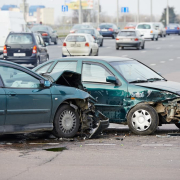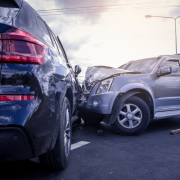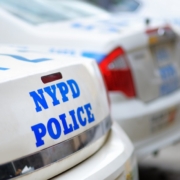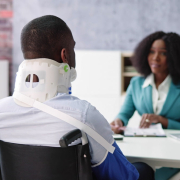Public Transportation and Bus Accidents
New York, NY USA – May 27, 2022: New York City, MTA Bus on Manhattan Street. (Shutterstock)
By Linda Nwoke
New York City has one of the most complex and extensive public transportation systems across the country, serving over 15 million people. In a large and congested city like New York, most people don’t use private vehicles to move around. Instead, for convenience, affordability, and swift movement, residents and tourists alike rely predominantly on public transport and transit for getting around to their various destinations. Data shows that 54% of households in New York City do not own a car and often rely on the public transport system comprising a network that encompasses buses, trains, ferries, and subways.
The City’s public transportation network is managed by the Metropolitan Transportation Authority (MTA) and New York City Transit. The operators of the services are required to undergo training and acquire knowledge about the rules and regulations of the industry for the protection of the passengers.
Breakdown of Public Transport Usage in New York
Among New York City commuters, over 35% use the subway, 11% take the bus, 7% travel by commuter rail, 22% drive alone, 9% walk to work, and 4% carpool. The number of people using taxis, cycling, or traveling by ferry remains comparatively minimal.
In 2019, over 2 million riders took the bus daily, with 678 million rides annually by January 2020. NYC has around 5900 buses, plying along 234 local, 20 Select Bus Service, and 73 express bus routes within the five boroughs. Manhattan has one of the busiest routes, followed by Bronx and Brooklyn. The longest local bus route is on Staten Island’s S78 between the St George Ferry Terminal and the Bricktown Mall in Charleston.
Bus Accidents in New York City
As expected, with such a vast operation and complex service, managing thousands of buses daily by the Metropolitan Transportation Authority in the City, it is inevitable that accidents will occur. However, it becomes a source of concern when accidents become frequent. Various factors, ranging from inadequate training, reckless driving by MTA drivers, laxity in MTA’s supervision, fatigue, poor weather conditions, careless pedestrians, can contribute to serious bus accidents in and around the City, causing injuries or death.
An article from the New York Post reports that available statistics over the past three years, MTA buses were involved in more than 21,000 crashes, at an average of 23 bus accidents per day. More than ten people died within the timeframe, and over 2,500 people were injured in bus accidents.
Considering the size and capacity of an MTA bus, any negligence on the part of the bus operator or the bus company can cause serious injuries, including spinal, head injury, burns, internal organ damage, amputation, disfigurement, and death of the injured victim.
The impact is often devastating, as in the case of Lance Margolin. He lost his life from the accident on April 8th, 2021, along Eastern Parkway, when an MTA bus struck a traffic camera pole that fell on him leading to his unprecedented death. The force from the weight of the camera pole caused him massive internal injuries and skull fractures.
Inside the bus, there have been cases of people being injured while riding on a bus operated by New York City Transit. In some instances, bus passengers may be injured due to a driver’s negligence, such as a driver failing to make a complete stop for a passenger’s safe disembarking or onboarding.
Other accidents can happen when a bus strikes another vehicle or a pedestrian or bicyclist. They can also malfunction due to defective equipment or poor maintenance. Thus, transit bus accidents fall into organizational Public Transport Related causes and passenger-related causes.
Importance of New York Public Transportation and Bus Safety
Public transportation is expected to improve road safety by reducing vehicular traffic. Therefore, security in transit buses is crucial for passengers’ confidence in the Public Transport and the companies that operate the services due to its far-reaching effect on the economy and beyond.
Consequently, frequent bus accidents increase the cost of operation in an industry dealing with budgetary shortfalls and low revenues, leading to a decrease in service reliability, safety, and potential settlements to victims and their families.
Bus accidents can affect their opinion and usage from the passenger’s perspective, requiring a campaign to raise confidence, such as the NYC Vision Zero Plan and the most recent ‘Stop Let Them Cross.’
What to Do If You’re Hurt on NYC Public Transportation
Despite the effort, injured individuals on public transportation like a Bus in New York City can become entitled to compensation for lost wages, medical bills, pain and suffering, and other losses. The authorities behind public transport have a duty of care toward pedestrians, bicyclists, and public transport users. However, if breached, they can be found liable for negligence that caused the injuries or death.
For any injury victim, you should take the following steps to protect yourself if you need to file a claim.
- Document: Gather evidence from the scene as photographs or videos, especially for evidence in a personal injury case. You or someone can help you achieve this using the camera on your phone.
- Witnesses: If you can, try and obtain the contact information of any passerby who saw the incident. Eyewitness accounts and statements collected as soon as the event happened are crucial. This can be achieved with a recorded video statement. Avoid time-lapse as memories fade quickly, and recollection becomes difficult.
Call the police or ambulance: If you or the injured victim suffered an injury, an official record of the incident is essential. Official records from the police or ambulance attendant on your account of what happened must be accurately documented in a police report or ambulance report in case of a lawsuit f to recover damages.
- Seeking medical help: When an accident occurs, the body’s natural response causes the victim to feel solid and ready for a fight or flight. Adrenaline tends to run high after an accident, and it can sometimes mask the symptoms of an injury. However, injury victims start feeling pain hours or days after an accident. That’s why it’s always a good idea to go to a hospital emergency department or see a private doctor after an accident.
- Get legal assistance: In seeking legal assistance, a person injured in this type of situation is wise to identify legal counsel that has specific experience in protecting the legal rights and interests of people hurt in a bus accident and public transportation. Call the Personal Injury Law Firm of Figeroux & Associates at 855-768-8845 or visit www.askthelawyer.us to schedule an appointment.












Leave a Reply
Want to join the discussion?Feel free to contribute!